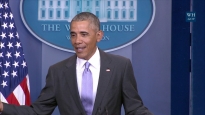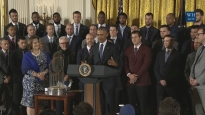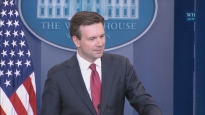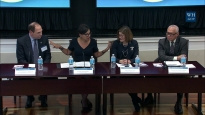President Obama Announces the First Five Promise Zones
January 09, 2014 | 25:31 | Public Domain
The Promise Zone Initiative is part of the President’s plan to create a better bargain for the middle-class by partnering with local communities and businesses to create jobs, increase economic security, expand educational opportunities, increase access to quality, affordable housing and improve public safety.
Remarks by the President on Promise Zones
East Room
2:24 P.M. EST
THE PRESIDENT: Well, welcome to the White House, everybody. And that was one of the best introductions I’ve ever had. (Applause.) So we’re so proud of Kiara for the introduction and for sharing your story, and you’re just so poised. And I know Geoff Canada is just out there all excited -- (laughter) -- and proud, and I know your mom is proud. I know she is. She should be.
Kiara and the rest of these young people grew up in a 97-square-block section of Harlem. It’s a place where the odds used to be stacked against them every single day, even just graduating from high school was a challenge. But with the help of some very dedicated adults and a program called the Harlem Children’s Zone, they’re right on track to go to college. Together, students, teachers, administrators, parents, community, they’re changing the odds in this neighborhood. And that’s what we’re here to talk about today -– changing the odds for every American child so that no matter who they are, no matter where they are born, they have a chance to succeed in today’s economy.
Now, the good news is that, thanks to the hard work and sacrifice of the American people all across the country over the last five years, our economy has grown stronger. Our businesses have now created more than 8 million new jobs since the depths of the recession. Our manufacturing, our housing sectors are rebounding. Our energy and technology and auto industries are booming. We’ve got to keep our economy growing. We’ve got to make sure that everybody is sharing in that growth. We’ve got to keep creating jobs, and then we’ve got to make sure that wages and benefits are such that families can rebuild a little bit of security. We’ve got to make sure this recovery, which is real, leaves nobody behind. And that’s going to be my focus throughout the year.
This is going to be a year of action. That’s what the American people expect, and they’re ready and willing to pitch in and help. This is not just a job for government; this is a job for everybody.
Working people are looking for the kind of stable, secure jobs that too often went overseas in the past couple of decades. So next week, I’ll join companies and colleges and take action to boost high-tech manufacturing -- the kind that attracts good new jobs and helps grow a middle class. Business owners are ready to play their part to hire more workers. So this month, I’m going to host CEOs here at the White House not once, but twice: First to lay out specific steps we can take to help more workers earn the skills that they need for today’s new jobs; second, they’re going to announce commitments that we’re making to put more of the long-term unemployed back to work.
And on January 28th, in my State of the Union address -- which I want all the legislators here to know I’m going to try to keep a little shorter than usual -- (laughter) -- they’re cheering silently -- (laughter) -- I will mobilize the country around the national mission of making sure our economy offers every American who works hard a fair shot at success. Anybody in this country who works hard should have a fair shot at success, period. It doesn’t matter where they come from, what region of the country, what they look like, what their last name is -- they should be able to succeed.
And obviously we’re coming off of a rancorous political year, but I genuinely believe that this is not a partisan issue. Because when you talk to the American people, you know that there are people working in soup kitchens, and people who are mentoring, and people who are starting small businesses and hiring their neighbors, and very rarely are they checking are they Democrat or Republican. There’s a sense of neighborliness that’s inherent in the American people -- we just have to tap into that.
And I’ve been very happy to see that there are Republicans like Rand Paul, who’s here today, who are ready to engage in this debate. That's a good thing. We’ve got Democratic and Republican elected officials across the country who are ready to roll up their sleeves and get to work. And this should be a challenge that unites us all.
I don't care whether the ideas are Democrat or Republican. I do care that they work. I do care that they are subject to evaluation, and we can see if we are using tax dollars in a certain way, if we’re starting a certain program, I want to make sure that young people like Kiara are actually benefiting from them.
Now, it’s one thing to say we should help more Americans get ahead, but talk is cheap. We’ve got to actually make sure that we do it. And I will work with anybody who’s willing to lay out some concrete ideas to create jobs, help more middle-class families find security in today’s economy, and offer new ladders of opportunity for folks to climb into the middle class.
And, personally, I hope we start by listening to the majority of the American people and restoring the unemployment insurance for Americans who need a little help supporting their families while they look for a new job. And I’m glad the Republicans and Democrats in the Senate are working together to extend that lifeline. I hope their colleagues in the House will join them to set this right.
Today I want to talk about something very particular, a specific example of how we can make a difference. We are here with leaders who are determined to change the odds in their communities the way these kids and their parents and dedicated citizens have changed the odds in Harlem. It’s now been 50 years since President Johnson declared an unconditional War on Poverty in America. And that groundbreaking effort created new avenues of opportunity for generations of Americans. It strengthened our safety net for working families and seniors, Americans with disabilities and the poor, so that when we fall -- and you never know what life brings you -- we can bounce back faster. It made us a better country and a stronger country.
In a speech 50 years ago, President Johnson talked about communities “on the outskirts of hope where opportunity was hard to come by.” Well, today’s economic challenges are different but they’ve still resulted in communities where in recent decades wrenching economic change has made opportunity harder and harder to come by. There are communities where for too many young people it feels like their future only extends to the next street corner or the outskirts of town, too many communities where no matter how hard you work, your destiny feels like it’s already been determined for you before you took that first step.
I’m not just talking about pockets of poverty in our inner cities. That's the stereotype. I’m talking about suburban neighborhoods that have been hammered by the housing crisis. I'm talking about manufacturing towns that still haven't recovered after the local plant shut down and jobs dried up. There are islands of rural America where jobs are scarce -- they were scarce even before the recession hit -- so that young people feel like if they want to actually succeed, they've got to leave town, they've got to leave their communities.
And I've seen this personally even before I got into politics. In fact, this is what drove me into politics. I was just two years out of college when I first moved to the South Side of Chicago. I was hired by a group of churches to help organize a community that had been devastated when the local steel plants closed their doors. And I'd walk through neighborhoods filled up with boarded-up houses and crumbling schools, and single parents and dads who had nothing to do with their kids, and kids who were hanging out on the street corners without any hope or prospects for the future.
But these churches came together. And then they started working with other non-profits and local businesses. And the government -- local, state and federal -- participated. And we started getting some things done that gave people hope. And that experience taught me that government does not have all the answers -- no amount of money can take the place of a loving parent in a child’s life. But I did learn that when communities and governments and businesses and not-for-profits work together, we can make a difference. Kiara is proof -- all these young people are proof we can make a difference.
For the last 17 years, the Harlem Children’s Zone -- the brainchild of Geoffrey Canada, who’s here today -- has proven we can make a difference. And it operated on a basic premise that each child will do better if all the children around them are doing better. So in Harlem, staff members go door to door and they recruit soon-to-be parents for “Baby College,” preparing them for those crucial first few months of life; making sure that they understand how to talk to their child and read to their child, and sometimes working with parents to teach them how to read so they can read to their child and give them the healthy start that they need.
And then, early childhood education to get kids learning at four years old. And then a charter school that help students succeed all the way through high school. And medical care and healthy foods that are available close to home. And exercise. I was very pleased to hear that -- Michelle was very pleased to hear that -- (laughter) -- that they've got a strong Phys Ed program. And then students getting help finding internships and applying to college, and an outstanding, dedicated staff that tries to make sure that nobody slips through the cracks or falls behind.
And this is an incredible achievement, and the results have been tremendous. Today, preschool students in the Harlem Children’s Zone are better prepared for kindergarten. Last year, a study found that students who win a spot in one of the charter schools score higher on standardized tests than those who don’t. In a neighborhood where higher education was once just something that other people did, you’ve got hundreds of kids who’ve now gone to college.
And Harlem is not the only community that’s found success taking on these challenges together. In Cincinnati, a focus on education has helped to make sure more kids are ready for kindergarten. In Nashville, they’ve redesigned high schools and boosted graduation rates by almost 20 percent over the past 12 years. In Milwaukee, they’ve cut teen pregnancy in half.
Every community is different, with different needs and different approaches. But communities that are making the most progress on these issues have some things in common. They don't look for a single silver bullet; instead they bring together local government and nonprofits and businesses and teachers and parents around a shared goal. That's what Geoffrey did when he started the Harlem Children’s Zone. Government was involved -- so don't be confused here, it has an important role to play. And already there are government resources going into these communities. But it’s important that our faith institutions and our businesses and the parents and the communities themselves are involved in designing and thinking through how do we move forward.
And the second thing is they’re holding themselves accountable by delivering measurable results. We don't fund things, we don't start projects just for the sake of starting them. They’ve got to work. If they don't work we should try something else. And sometimes those of us who care deeply about advancing opportunity aren't willing to subject some of these programs to that test: Do they work?
In my State of the Union address last year, I announced our commitment to identify more communities like these -- urban, rural, tribal -- where dedicated citizens are determined to make a difference and turn things around. And we challenged them. We said if you can demonstrate the ability and the will to launch an all-encompassing, all-hands-on-deck approach to reducing poverty and expanding opportunity, we’ll help you get the resources to do it. We’ll take resources from some of the programs that we're already doing and concentrate them. We'll make sure that our agencies are working together more effectively. We'll put in talent to help you plan. But we're also going to hold you accountable and measure your progress.
And if you're doing real stuff that is making a difference in the lives of young people like Kiara, then we're going to be there. Your country will help you remake your community on behalf of your kids, family by family, block by block.
We call these communities Promise Zones. They’re neighborhoods where we will help local efforts to meet one national goal -- that a child’s course in life should be determined not by the zip code she’s born in, but by the strength of her work ethic and the scope of her dreams.
So we're here today to announce the first five Promise Zones in America. And I could not be prouder to be joined by Mayor Eric Garcetti of Los Angeles; and Mayor Michael Nutter of Philadelphia; and Councilwoman Ivy Taylor from San Antonio; Chief Gregory Pyle, one of our tribal leaders, and Jerry Rickett from the Kentucky Highlands Investment Corporation -- some of the leaders from these neighborhoods who are helping to make it happen.
In the East Side neighborhood of San Antonio, nearly four in 10 adults don’t have a high school diploma. The violent crime rate is 50 percent higher than the rest of the city. So schools and community members are focused on getting more kids into pre-K, boosting math and science in high school, and they’re putting more cops on foot patrol to make their neighborhoods safer. It's a project worth investing in.
In a section of L.A. that stretches from Pico-Union to Hollywood, the population decreased by 13,000 people in just 10 years. So developers are working to build more affordable housing; technical schools and community colleges are helping more people get the training they need to get jobs. It's a project worth investing in.
In Philly, nearly four out of every 10 kids lives below the poverty line –- and a lot of them are on the West Side of the city. So a local university is helping connect middle and high school students with mentors to get them ready for college. You've got a supermarket that’s being planned that will create jobs and provide healthy food where there’s been too little of both. We're going to invest in that.
In Senator Mitch McConnell’s home state of Kentucky, there are communities that have been struggling for decades with shutdowns and layoffs. So they’re taking steps, locally initiated, to attract new businesses and create new jobs in new industries. You've got a local college that's stepping up to expand technical training and help more kids get a higher education.
And in the Choctaw Nation of Oklahoma, where up to half of the residents in some areas live in poverty, community leaders are determined to change things. And they’re making financing available to help women start their own businesses; they're investing in new water and sewer systems that will make the area more attractive for companies looking to locate there; and they’re helping farmers and ranchers create more jobs, and more families thereby get access to healthy foods.
So these are America’s first five Promise Zones. And over the next three years, we're going to help launch 20 in all. And each of these communities is designing from the bottom up, not the top down, what it is they think they need, and we're working with them to make that happen. And each of these communities is prepared to do what it takes to change the odds for their kids. We will help them succeed -- not with a handout, but as partners with them every step of the way. And we're going to make sure it works, and we're going to hold them accountable to make sure it is making a difference in the lives of kids.
As a nation, we've got plenty of reasons to hope. And I just want to end with one story just to give you a sense of what we're talking about here. Roger Brown came here today from Harlem. Where is Roger? There he is right here. I used to have a haircut like that -- (laughter) -- and maybe after I'm done with the presidency, I'm going back to that. (Laughter.)
Growing up -- I want you to listen to Roger's story, because it's unique and it's special, but it's also representative. Growing up, Roger spent some time in the foster care system before going to live with his mom, who was working two jobs to make ends meet. When Roger was in 6th grade, his mom entered his name in the Promise Academy Charter School lottery and prayed. And Roger won a spot.
Now, the way I hear it, Roger, you were still having some problems sometimes. He was the class clown and acting out, and almost got himself expelled. But the teachers and the staff did not give up on him. They saw something in him. They kept pushing him. And then one summer when Roger was home visiting his foster family, he looked around the room and he realized nobody in that room had gone to college, and nobody in that room had a job. And at that moment, something clicked. And Roger decided he wanted something better for himself -- and for his mom and for his two sisters that looked up to him.
So Roger buckled down. He went from failing his classes to passing his classes. He became a member of the first graduating class at the Promise Academy. (Applause.) And today Roger is a sophomore at Hunter College in New York, one of the best colleges in the country -- the first person in his family to get that far. And now he wants to go to medical school and become a neurologist. (Applause.)
If you want to know why I care about this stuff so much, it's because I'm not that different from Roger. There was a period of time in my life where I was goofing off. I was raised by a single mom. I didn’t know my dad. The only difference between me and Roger was my environment was more forgiving than his. That’s the only difference. If I screwed up, the consequences weren't quite as great.
So if Roger can make it, and if I can make it, if Kiara can make it, every kid in this country can make it. But we've got to believe in that. We can't just give lip service to it. And it can't just get caught up in a bunch of political arguments.
There are legitimate questions about how the best way to do this is, how we can best make progress. And there are legitimate debates to be had about how big of a role is government in that process, how big of a role is the private sector. And there's no disagreement that there has to be individual initiative -- it's got to start inside. Roger had to have a change of attitude. I had to have a change of attitude. Kiara -- she probably didn’t need a change in attitude. (Laughter.) She was focused the whole time.
We don’t dispute that, but we do know that sometimes we talk about this stuff as if we care and then we don’t deliver. We don’t follow through. We don’t make the effort. It's not sustained. We lose interest. And then we say to ourselves, well, maybe nothing can be done, and we put up with it. And as a consequence, a lot of our kids get lost. And we can't allow that to happen. That’s what the Promise Zones represent.
I want more kids to have the chance that Roger got. I want more kids to have the chance this country gave me. We should all want every one of our kids and their families to have a shot at success. If you are willing to dream big and work hard, you should grow up with the same opportunities in life as any other child living in any other place.
That’s what we're fighting for. That’s what America is about. So let's act. Let's make it happen this year, all right?
Thank you. God bless you. God bless America. (Applause.)
END
2:49 P.M. EST
|
January 18, 2017
|
January 17, 2017
|
January 16, 2017
|
January 16, 2017
|
|
January 14, 2017
|
January 13, 2017
|
January 13, 2017
|
January 12, 2017
|







